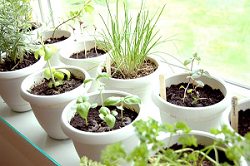How Plants Work
Things you need to know covers all of the little things that other stores overlook -- and we put importance to.
 A
basic understanding of how plants grow and what they need for optimal
growth is crucial to both indoor and outdoor gardeners. If you
are gardening outdoors, Mother Nature handles most of a plants needs.
With hydroponic gardening, you must provide some of the plants
necessary requirements in other ways. This section will help you
understand the process of what a plant needs.
A
basic understanding of how plants grow and what they need for optimal
growth is crucial to both indoor and outdoor gardeners. If you
are gardening outdoors, Mother Nature handles most of a plants needs.
With hydroponic gardening, you must provide some of the plants
necessary requirements in other ways. This section will help you
understand the process of what a plant needs.
About Plants and Their Basic Needs
Plants are made up of eight different parts and
each part has an important function in the growing process. Our
main concern, however, is with the leaves, roots, root hairs and the
vascular system. These are the parts of a plant that contribute to the
success of the flowers and fruits.
|
● Fruit
● Flower
● Leaf
● Phloem
● Roots
|
» Leaves - Leaves are where photosynthesis takes place and light and carbon dioxide are taken in, with oxygen released as a by-product. On the underside of leaves, small openings called "stomata" open and close, allowing carbon dioxide to enter and oxygen to exit.
» Roots - The roots anchor a plant in the ground and absorb water, nutrients and air. Tiny root hairs increase the surface area of the root for faster absorption. These tiny root hairs are extremely delicate and must be kept moist at all times. Larger roots are similar to the plants stem, as they transport water and dissolved minerals to the plant.
 »
Stems & Vascular System (Xylem &
Phloem)
- The stems are the
heart of a plants vascular system and carry water and nutrients
throughout the plant. The xylem carries water and nutrients from the
roots to the leaves, and the phloem transports food manufactured by
the leaves to the stems and roots. The stem also supports the plant
and bears leaves, flowers buds, and fruits.
»
Stems & Vascular System (Xylem &
Phloem)
- The stems are the
heart of a plants vascular system and carry water and nutrients
throughout the plant. The xylem carries water and nutrients from the
roots to the leaves, and the phloem transports food manufactured by
the leaves to the stems and roots. The stem also supports the plant
and bears leaves, flowers buds, and fruits.
Plants have five basic needs and each one of these accounts for 20% of a plants ability to grow to it fullest potential. The amazing thing is that if one of these needs is only partially met, all of these needs are negatively affected in a chain reaction. For example, if a plant receives only 10% of its needed nutrients, that does not cause just a 10% negative impact on nutrients. It creates a 10% negative effect on all of the other needs as well. Maintaining a proper balance of all factors that affect a plants health is your best assurance of gardening success.
» Air
- temperature, humidity, and CO2 & O2 Content
» Growing - air
content and moisture content
» Light
- spectrum (color), intensity and hours of light per day
» Nutrients -
composition and purity
» Water - air
content and moisture content
